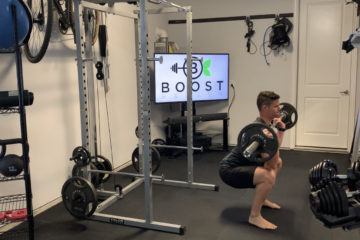
This is another post where there was so much great content in the podcast it was difficult to capture in blog form. I suggest listening to the show in your favourite podcast app below to get the full experience. Below are notes of what we covered in part 1 of this 3 part series.
I have a special guest with me today, Mr. Joel Lieginger. He is a very good friend of mine whom I met through the SIRs cycling club here in Hong Kong.
I asked Joel to be on the show today because he has a lot of experience and perspective in a fitness discipline I have become obsessed with lately. I think adding in this discipline is a tremendous opportunity to improve my health and fitness. Before we dig into what this new obsession of mine is, I want to tell you a little bit about Joel.
Joel has lived in Hong Kong with his wife Emily and three kids Charlie, Eleanor, and Elizabeth, for the past 8 years. He works at a little company called AIA, that for those of you listening from other parts of the world, is the largest insurance company across Asia, and he has been with AIA, in numerous roles, for his full time in HK, and currently runs their third party distribution platform.
As for a little more on Joel’s personal background before we get into the show, Joel’s athletic background covers team and individual sports, and both organized and outdoor activities. He grew up as many of us did playing numerous sports, and his include swimming competitively, baseball, soccer, tennis, football, rugby, and ice hockey. He then spent 10 years doing triathlon and was a solid age group competitor in the US, before having kids and stepping back from the sport. And more recently he’s a keen cyclist and cross fitter, to keep himself tuned up for his real passions of skiing in the winter.
As you know by now, the theme of this blog and podcast is to try new wellness tactics and see what sticks for YOU. It is a personal journey as we all respond differently to different stimuli. Somehow along my wellness journey I had not truly discovered mobility. I have danced all around it with disciplines such as dynamic warm up, foam rolling and smashing, yoga, ELDOA, and flexibility training. These can assist with mobility but they aren’t really a dedicated mobility program. What do I mean? Isn’t flexibility, mobility? No.
Let me explain with an example. A couple months ago I did a cycling race put on by the Dragons Triathlon club here in Hong Kong.
Pistol Squat Discovery
It was a 4 man time trial race across 48km and our team was comprised of my buddies Joel, Ric, Tom, and myself. We worked hard and put in a good effort on the course. Afterward we were having coffee and the topic of functional fitness and mobility came up. Joel decided to perform a pistol squat in reference to mobility. He executed a perfect pistol squat, shortly after completing a gruelling race mind you, and we were very impressed. If you are not familiar with a pistol squat, it is regarded by many as one of the best exercises to showcase fitness ability. In the most basic terms, you are completing a squat on one leg while extending the opposite leg straight out in front of the body.
You can see a beautifully executed pistol squat here by calisthenics expert and Certified Strength and Conditioning Specialist, Al Kavadlo. The reason it is highly regarded, is also the same reason a pistol squat should be slowly worked up to. Also, as promised, here is Joel doing his technically sound pistol.
For those of you who follow me know I designed a pretty well-rounded fitness program for myself. I do full body strength training 3 times per week, cycling, swimming, running, dynamic warmups before all workouts and sports, and cool downs with stretching. Within these disciplines I would say I am quite strong when looking at classic movements like squats, presses, and deadlifts. I would also say I am quite flexible if you look at standards like the seat and reach. But, with all of this training and ability, I was not able to even come close to performing the pistol squat correctly. Why? The answer, as I have come to learn, is my lack of mobility.
Mobility Is Not Flexibility
There is a great article on the shape.com website that goes into the difference between mobility and flexibility. Fellow Certified Strength and Conditioning Specialist (CSCS), Grayson Wickham, very nicely describes flexibility as the temporary elongating of your connective tissue, and mobility, as moving muscles under control through range of motion in the joint socket. He suggests that flexibility, body awareness, strength, and coordination are all components of mobility.
This is a brilliant way to think of mobility and also quite intuitive. For example you may have very good body awareness and flexibility, but if you don’t have enough strength and coordination in your hips and glute muscles, then you may not be able to properly perform a proper squat.
Joel can you tell us the story of how you got interested in mobility work?
I heard you once say that mobility work “changed your life”. How so?
Mobility, Fix Me Please
I don’t like to not be good at something, especially in the fitness arena. In addition to my renewed interest and understanding of mobility I have been inspired to take new action as I have struggled with a knee injury this year. My osteopath feels it may be a tracking issue. It is something I haven’t been able to shake for a few months now. The knee only hurts when I run. Luckily I can do strength training, mobility work, swimming, and biking, all without issue. My hope is that this additional mobility training will help with some apparent imbalances. Perhaps improving mobility in the hips, ankles, calves, and back, can provide me the ability to run on the knee again pain free. I will keep you posted on that.
Do you recall having a period of soreness in back, hips, anywhere when you first got started?
Did you have any issues with lack of mobility in your ankles when you first got started?
To be continued in parts 2 and 3….
Podcast: Play in new window | Download
Subscribe Apple Podcasts | Google Podcasts | RSS







